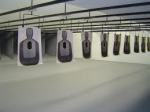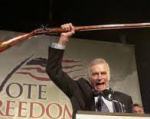Michael R. Weisser's Blog, page 124
January 20, 2015
Here’s The Latest In Gun Fashion For Women Who Carry A Gun.
I wasn’t surprised when the news about the unfortunate shooting of Veronica Rutledge by her two-year old son revealed that the kid had evidently pulled Mom’s gun out of a specially-designed gun tote bag that she had received as a Christmas gift, because those kinds of items have been around for a few years. But I did a double-take earlier this week when I received an email from the NRA pushing the sale of various shooting accessories and one of the items was a “Flashbang” woman’s holster designed to be attached and worn between the two cups of a bra. To quote the ad: “Simply pull up your shirt with one hand and pull down on your pistol with the other – in a matter of seconds you’ve safely deployed your self-defense sidearm.”
The NRA has been pushing the women as shooters for the last few years with the consequent appearance of feminine-styled products like clothing, jewelry, pink gun grips and the like, but sticking a gun into a molded holster and then concealing the holster in the cleavage between a woman’s breasts really takes the cake. And what I love most of all is the gung-ho image of raising the garment up with one hand and yanking out the gun with the other. If this isn’t right out of some early Angelina Jolie action flick that she and Brad would now rather forget, I don’t know what’s what.
 The only problem with this marketing plan is that the movement of women into becoming serious shooters hasn’t really caught on. Yea, yea, I know there are a few blogs out there for the chicks with guns and the NRA video channel features some girls who look like they almost made the final cut to do commentaries on Fox News or sideline interviews for the NFL. But if all those women are flocking into gun shops to get all armed up, how come gun sales continue to slide?
The only problem with this marketing plan is that the movement of women into becoming serious shooters hasn’t really caught on. Yea, yea, I know there are a few blogs out there for the chicks with guns and the NRA video channel features some girls who look like they almost made the final cut to do commentaries on Fox News or sideline interviews for the NFL. But if all those women are flocking into gun shops to get all armed up, how come gun sales continue to slide?
Last year the NRA rewrote its training course known as “Personal Protection in the Home.” In fact, the intro says that the course was especially developed by the “women of the NRA.” The course, which I am certified to teach, explains “how to make your home less appealing to professional criminals, avoiding confrontation, and thoroughly covers the practical use of a firearm as a last resort to defend your home and family.” It covers subjects like security systems, telephone and other communications, locks on windows and doors and, of course, some hands-on training if either you or the trainer happens to show up with a gun. There’s even a section on what to do and what not to do after you’ve shot the bad guy coming through the back door; i.e., don’t touch the body, keep your mouth shut when the cops arrive, make sure you have a good lawyer, all the usual stuff. Interesting that there’s nothing in the course about what to do if the bad guy shoots you first.
The truth is that where women are concerned, most if not nearly all the “bad guys” who attack them happen to be their husbands, their ex-husbands or their boyfriends, none of whom are considered to be “professional criminals” by any stretch at all. In fact, women are 15% of the homicide victims each year, most of them killed with a gun, and when a woman does pull out a piece and bangs away, it’s always a husband, a lover or some other type of intimate partner violence that provoked the use of a gun.
Last week Michigan’s Republican Governor, Rick Snyder, vetoed a bill that would have lessened certain safeguards for the issuance of CCW permits where there was a history of domestic abuse. In their usual fashion the NRA supported the bill because any removal of restrictions on gun ownership leads to more guns. The NRA is delusional if it really believes that women will buy into any kind of self-protection that doesn’t start and end with the issue of IPV. And women aren’t going to be persuaded otherwise because they can now use a holster to buckle themselves up.

January 18, 2015
Is There A Link Between Guns And Crime? It’s Not What The NRA Thinks It Is
When I was a kid growing up in New York City we kept our eyes on a neighborhood gang whose older members, when it came to violence and lawlessness, put the feared Westies to shame. In fact, the Westies contracted out their hits to this bunch, whose SOP was to haul the victim up to the roof of one of the neighborhood housing projects and that was that. Five guys went up to the roof, four guys walked back down.
As tough and brutal as they were, the members of this crew never carried guns. Why not? Because whenever anything went down in the neighborhood, the cops would come around, line them up against the wall, administer the Miranda warning by kicking them in the ass or a punching them in the face, and then pat them all down for guns. If the cops found a gun, that guy was slammed into the back of the patrol car and wasn’t seen for a long time. Don’t think for one second that aggressive, in-your-face street patrols used by Giuliani and Bloomberg to drive down gun crime in New York City was such a new idea.
 The NRA and the gun industry wants us to take a giant leap of faith by going along with their idea that the most effective way to curb gun violence is to cut down on crime. But the data on gun violence published by the FBI doesn’t support this, not at all. Of course there are criminals out there who use guns to commit guns. Of course we need to do everything possible to keep guns out of the wrong hands. But the connection of guns to gun violence is more complicated than just the simple idea that more guns in the “wrong hands” equals more crime.
The NRA and the gun industry wants us to take a giant leap of faith by going along with their idea that the most effective way to curb gun violence is to cut down on crime. But the data on gun violence published by the FBI doesn’t support this, not at all. Of course there are criminals out there who use guns to commit guns. Of course we need to do everything possible to keep guns out of the wrong hands. But the connection of guns to gun violence is more complicated than just the simple idea that more guns in the “wrong hands” equals more crime.
According to the FBI, from 2000 to 2012 there were slightly more than 200,000 homicide victims of which slightly more than two-thirds were killed with guns. This is an average of 10,400 gun homicides each year, a remarkably-stable number over the past thirteen years. Of these gun killings, slightly more than 15% involved women as victims, or roughly 21,000 over the same span of years. When women are homicide victims, most if not virtually all of these shootings grew out of some sort of IPV. Let’s not forget, incidentally, that men were also shot to death by women an average of 700 times per year. Taken together, domestic violence probably claimed more than 2,200 victims annually between 2000 and 2012, or one-fifth of all gun fatalities during those years.
The degree to which homicide grows out of personal disputes is shown by the fact that of the total murders committed in 2012, only slightly more than 20% took place during the commission of other crimes. The rest happened because people who knew each other, and in most cases knew each other on a long-term, continuous basis, got into an argument about money, or who dissed who, or who was sleeping with someone else, or some other dumb thing. And many times they were drunk or high on drugs, but no matter what, like Walter Mosley says, “sooner or later” the gun goes off.
Here’s the bottom line on gun violence and crime. Every year 20,000+ shoot themselves intentionally, which is suicide. Another thousand, give or take a hundred, kill themselves
accidentally with a gun. Then another 10,000 use a gun to kill someone else, but 8,000 of those shootings had nothing to do with other violent crimes. If we define gun violence as using a gun to end a human life, the FBI is telling us that less than 10% of those fatalities would be eliminated if we got rid of all violent crime. The NRA can try to convince its membership that the reason for gun violence is that there’s too much crime, but the data from the FBI clearly indicates that the reason for gun violence is that there are too many guns.
Get it at Amazon.

January 17, 2015
Want An Honest Discussion About Gun Violence? Don’t Look To Dr. Young.
There’s a crackpot group of physicians out there who call themselves Doctors for Responsible Gun Ownership, and every once in a while some pro-gun media outlet gives them some space to promote the idea that guns do not constitute a health risk and, in fact, that guns keep us healthy and safe. Lately their pronouncements have come from an upstate, New York psychiatrist, Robert Young, who was given some space on the gun blog The Truth About Guns to deliver a series of utterly false and misleading statements about the medical impact of gun violence.
Why were his statements false and misleading? Because Young doesn’t believe there’s something called gun violence. According to him, the term was invented by anti-gun advocates to make people believe that guns are somehow the cause of gun violence, when in fact guns are what keep us safe from violence. Dr. Young goes notes that “most academic physicians follow the ossified, over 20-year-old anti-gun position of their leadership that ‘gun violence is a public health issue.’” He then goes on to score a recent Washington Post op-ed piece in which the contributor, another physician, ignored the problems of poverty, domestic violence and childhood exposure to bloodshed as the real reasons behind violence, none having anything to do with guns.
 Gun violence wasn’t ‘invented’ by anti-gun advocates; it was listed as a sub-category of violence in the very first assessment of public health issues when the CDC created the first such list in 1980, a list which included such other controversial public health risks as smoking, obesity, and excessive alcohol consumption. Now either Young knows this or he doesn’t. If he knows it, then he’s a liar. If he doesn’t, he’s a charlatan and a fool. Either way, his attempt to create the false impression that patterns of violence in this country can be fully understood without reference to the availability of guns is nothing more than the same old NRA script that has been floating around for the past twenty years.
Gun violence wasn’t ‘invented’ by anti-gun advocates; it was listed as a sub-category of violence in the very first assessment of public health issues when the CDC created the first such list in 1980, a list which included such other controversial public health risks as smoking, obesity, and excessive alcohol consumption. Now either Young knows this or he doesn’t. If he knows it, then he’s a liar. If he doesn’t, he’s a charlatan and a fool. Either way, his attempt to create the false impression that patterns of violence in this country can be fully understood without reference to the availability of guns is nothing more than the same old NRA script that has been floating around for the past twenty years.
The idea that guns are a health risk didn’t come out of thin air. It resulted from two decades of research that found a clear increase in homicides, suicides and gun morbidities in the populations that had access to guns. This research also found that the United States did not have higher levels of violence than other advanced, post-industrial countries, but we did have a much higher rate of mortality, again because of access to guns. Now don’t get me wrong. I’m not saying that these studies provide the basis for demanding that we pack up all the guns in America and dump them out at sea. There are certainly anti-gun zealots who would like this to happen, but that group doesn’t include me. What I am saying is, like it or not, gun violence is an issue of public concern and I would hope the debate would turn not on half-cocked rantings of Dr. Young, but on data and verifiable facts.
The real problem, according to Dr. Young, is that physicians “don’t often address the tragic crime epidemic among undisciplined teens and young adults competing for gang and drug turf and money.” The medical community works tirelessly and endlessly to address medical issues arising from the ravages of inner-city life, but the truth is that perhaps three-quarters of all fatal gun injuries result from social circumstances that may have little to do with crime. This is true of virtually all suicides, nearly all unintentional shootings, most if not nearly all IPV fatalities and a goodly number of so-called ‘street’ shootings, which turn out to be arguments between relatives, friends, or just an occasional babysitter who plops the kid down a flight of stairs.
Shameless NRA sycophants like Robert Young won’t admit that most of the deaths associated with guns in this country occur because there are an awful lot of guns. Again, I’m not advocating nor have I ever advocated more legal controls over guns. But I do want the issue faced and discussed in honest terms. It’s too bad we don’t get any honesty from the likes of Doctor Young.

January 15, 2015
Does Shooting A Gun Turn Someone Into A Gun Owner? I Don’t Think So.
The Washington Post can usually be counted on to carry an article now and again that challenges the gun lobby on issues related to gun ownership, gun violence, or other contentious topics related to guns. Recall that it was The Post which carried a multi-part, detailed series on gun dealers who sold most of the crime guns in northern Virginia, reportage which no doubt helped guide the Brady Organization to start up its “rotten apples” campaign against rogue dealers in Chicago and other locations.
 Now the Post has turned around and given a large, online editorial space to Michael Rosenwald, who went across the Potomac River to Manassas and evidently spent some time at the Elite Shooting Sports range, and then wrote an article describing the emergence of a new trend in the gun industry, something which he calls “guntry” ranges that allow patrons to rent guns and bang away either on a membership or per-try basis. Most shooting ranges have a collection of guns that can be rented or used by visitors (the real revenue at a range is from ammunition sales) but what makes ranges like Elite different, according to Rosenwald, is these enterprises cater to a “younger, more affluent, style-focused, increasingly female and even environmentally conscious” customer base, quite unlike the gritty, hard-core, blue-collar gunnies and trigger-heads that usually hang around the local gun range.
Now the Post has turned around and given a large, online editorial space to Michael Rosenwald, who went across the Potomac River to Manassas and evidently spent some time at the Elite Shooting Sports range, and then wrote an article describing the emergence of a new trend in the gun industry, something which he calls “guntry” ranges that allow patrons to rent guns and bang away either on a membership or per-try basis. Most shooting ranges have a collection of guns that can be rented or used by visitors (the real revenue at a range is from ammunition sales) but what makes ranges like Elite different, according to Rosenwald, is these enterprises cater to a “younger, more affluent, style-focused, increasingly female and even environmentally conscious” customer base, quite unlike the gritty, hard-core, blue-collar gunnies and trigger-heads that usually hang around the local gun range.
Rosenwald mentions other guntry locations in South Beach, Florida, and a few spots around the country, all of which are catering, according to him, to a “new breed” of shooter. And he paints a pretty accurate description of what he refers to as these “shooting retreats,” which, by the way, are usually part of a complex that includes a cigar lounge, a high-end restaurant, catering venues and other amenities that draw younger folks with a buck to spend.
That’s fine as far as it goes. But the moment that Rosenwald stops writing about what he knows – business – and begins writing about what he doesn’t know – the gun business – mistakes and misstatements abound. The truth is that there has yet to be any connection between the development of this business model, successful or not, and a penetration of gun sales into the younger, more affluent and more diverse population groups. Try as they might, the gun lobby has been unable to persuade racial minorities, women or more affluent/educated folks of the value of owning guns, and Rosenwald’s comment that gun sales are now “leveling out” is remarkably disingenuous. Does he really believe that a 40% decline in revenues of gun makers like Smith & Wesson and Ruger, along with major job layoffs, constitutes simply a leveling out? What it means is that once Obama-fear disappeared, the gun industry has not been able to attract buyers beyond the traditional White, older, blue-collar demographic, even if the kids on occasion want to stop playing video shooting games and try the real thing.
Rosenwald quotes the NSSF that Americans $10 billion yearly on target shooting, but he also says that the industry as a whole tracked up $15 billion last year in sales. Is he claiming that 2/3 of the revenue of the gun industry comes from people who just go out somewhere, set up a target and shoot their guns? That’s all fine and well except that hunters spend more than $38 billion annually on their hobby, and if you’re going to include in target shooting such expenditures as the cost of driving back and forth to the range, don’t you have to compare this number to the cost of driving back and forth to where someone went to hunt?
An article about the gun industry based on the unqualified statements of the NSSF may fill an op-ed piece for The Post, but it doesn’t help us understand the current debate about guns. If it were the case that gun makers were finding new markets, then perhaps the whole discussion about gun safety would need to change. Rosenwald may have found a new way in which Millennials spend their money, but shooting a gun and becoming a shooter are two very different things.

January 10, 2015
Do Guns Protect Us? Lott Says Yes, Violence Policy Center Says No.
The gun lobby was understandably quiet after the tragic shooting of Veronica Rutledge by her two-year old son in the Hayden, ID, Walmart. After all, it’s pretty tough to reconcile the human cost of such carelessness with the notion that people walking around with guns make themselves and others more safe. But sooner or later you can always count on John Lott, the author of More Guns, Less Crime to stomp into territory where others fear to tread, and he’s done it in this case with a Fox News blog in which he accuses the media of playing up the few instances of accidental shootings involving folks who legally carry guns, while ignoring or downplaying the many instances in which gun-carrying citizens protected themselves and others from crime.

John Lott
Lott’s been on this bandwagon about how guns protect us from crime for the past twenty years, and his alleged research is cited again and again by politicians and pro-gun enthusiasts who believe America should be fully armed. The only problem is that not only has his research been debunked by other scholars time and time again, but when a panel of criminologists asked him to furnish his data so that they could replicate his results, at first he couldn’t produce any data, and when he was submitted a ‘revised’ dataset, the subsequent analysis also didn’t hold up. But Lott isn’t interested in being a scholar; he’s promoting the value of owning guns.
Which is fine as far as it goes. A man has to earn a living after all. But Lott’s one-sided approach not only forces him to make arguments not supported by facts, but also to ignore data which, at the very least, throws the whole notion of CCW for personal defense up for grabs. I am referring here to the ongoing project of the Violence Policy Center to track killings by concealed-carry licensees, which shows that more than 600 people with CCW killed themselves or others since 2007. The study, of course, is based on media reports that have come to the attention of the VPC, so it is necessarily incomplete, and I suspect that in the suicide category, which comprises slightly less than one-third of the shootings, the real number is substantially higher than what is estimated to have really occurred.
 Most disturbing in the VPC report were the 29 mass shootings committed by CCW-legal individuals which resulted in 147 deaths, including 13 suicides by the shooters themselves. What is most concerning about this category is that we all assume that individuals who commit mass shootings are the most deranged and disturbed among us, and it’s the gun lobby more than any other group that has vociferously demanded that better screening be put in place to keep mentally-unbalanced individuals from getting their hands on guns. But it’s also assumed that when a jurisdiction grants a CCW permit, the scrutiny of that individual’s fitness goes beyond a mere background check. The data gathered by the VPC shows this assumption, like many of the assumptions about the value of CCW, to be wrong.
Most disturbing in the VPC report were the 29 mass shootings committed by CCW-legal individuals which resulted in 147 deaths, including 13 suicides by the shooters themselves. What is most concerning about this category is that we all assume that individuals who commit mass shootings are the most deranged and disturbed among us, and it’s the gun lobby more than any other group that has vociferously demanded that better screening be put in place to keep mentally-unbalanced individuals from getting their hands on guns. But it’s also assumed that when a jurisdiction grants a CCW permit, the scrutiny of that individual’s fitness goes beyond a mere background check. The data gathered by the VPC shows this assumption, like many of the assumptions about the value of CCW, to be wrong.
Lott gives the whole thing away and shows his true motives when he says that, “If Americans only hear about the bad things that happen with guns, they will be much more likely to support strict gun regulations.” And since more regulation usually leads to fewer guns, this is certainly not the direction which the gun lobby would like us to take. But simply claiming that guns make us safer while ignoring studies like the VPC report may play well to zealots like Ted Nugent and the NRA crowd, but it’s not in accord with the facts.
Don’t get me wrong. I’m licensed for CCW and I carry a gun from time to time. So I’m not opposed per se to the notion that guns do more harm than good. What I do oppose is constructing an argument for either position out of whole cloth, and John Lott has been stitching such an argument for longer than he should.

January 8, 2015
When It Comes To Guns, Physicians Should Forget The Hippocratic Oath.
Now that America finally has a Surgeon General, you would think that the debate over his appointment would give way to an honest and serious effort to evaluate Vivek Murthy’s performance as he leads the nation’s public health effort for at least the next two years. But there’s one guy out there who simply can’t leave the issue behind, and as he continues to fulminate over Obama’s choice for Surgeon General, the hot air and the lies continue to expand. I am referring to Tim Wheeler, the sometime head of an alleged organization which claims to represent thousands of physicians who support ‘responsible’ ownership of guns. The NRA has been pushing this quack into the public arena ever since the gun lobby decided that the listing of gun violence as a public health problem meant that physicians had become, to gun owners, Public Enemy Number 1.

Vivek Murthy, M.D.
I didn’t notice the automobile industry attacking physicians when car accidents made the list as a public health problem. In fact, Detroit collaborated with public health researchers when it came to designing and producing safer cars. The same could also be said of the household recreation industry which helped craft legislation passed by state after state which mandated that fences be installed around all in-ground, backyard pools. But somehow the gun industry decided that its products not only did more good than harm, but decided that they did so much more good than harm that the issues of lethality and safety risks didn’t need to be discussed at all. Enter Timothy Wheeler, who has doggedly led the fight to disconnect physicians from any public discussion or publicly-funded research about guns. And if you doubt the validity of anything he says, remember, this is a guy who claims to be an M.D.
Now I’m not an M.D. but I can do simple math. And if guns are the method of choice in 100,000 fatal and non-fatal but serious injuries each year, then we’re not talking about chopped liver in medical terms. We’re talking about a medical condition which costs countless lives, billions of dollars and untold family trauma each year, the human results of which inevitably end up in a critical-care treatment bay with the terrified family and friends waiting to be told whether they’ll ever be able to speak to the shooting victim again.
Wheeler’s latest effort to spread misinformation and stupidity about the role of physicians in gun violence is an op-ed on the National Review website which features his bizarre frothings from time to time. In this particular effort, he not only takes aim at Murthy and the potential danger that he represents for gun owners over the next several years, but he also repeats the fiction that physicians have no right to invade patients’ privacy by advocating “gun control” in the examining room.
If Wheeler is so lacking in the most rudimentary understanding of how medical professionals attempt to asses patient risk he can be excused if only because he may not know how much disinformation he’s handing out. But if he’s aware of how physicians are trained to assess medical risk then he’s just pandering to an audience who can be excused for not knowing what Wheeler’s supposed to be talking about.
Physicians usually begin an examination by asking the patient how he or she feels. The answer to that question prompts the next question, the answer to the next question prompts a third, a fourth and as many questions and answers as the physician needs to ask in order to assess the health risk of the patient sitting in the examination room. To place any limits on the doctor-patient exchange of information is to ask a physician to violate the Hippocratic oath. But Wheeler’s not interested in the method that physicians use to reduce harm. He’s interested in helping the NRA marketing team, which means he’ll say whatever the gun industry needs to have said in order to sell guns. He’s a good salesman from that point of view; as a physician he says things that simply aren’t true.

What Really Happened In Hayden.
By sheer coincidence, I first heard about the tragic death of Veronica Rutledge while I was visiting my step-son, his wife and his three-year old daughter. In fact, little Aliza was sitting right in front of me as I caught a bit of the story out of Hayden, and I couldn’t believe that a child who was even younger than my stepdaughter could have reached into a pocketbook, pulled out a 9mm pistol, somehow got his hand around the grip and shot it off.
My unease with the facts of the story grew greater when I then watched a report from KREM-TV, the station with reporters on the ground in Hayden, which showed a picture of the alleged weapon, which appeared to be a Smith & Wesson Model 3913. The 3913 is a mid-size pistol which, at least in the pic on KREM, shoots double-action only, which means a very long trigger pull. This is not a gun that a two-year old, it seems to me, could very easily (if at all) either hold or shoot. The story simply didn’t seem to fit and it was even more confusing because most of the ‘details’ about the victim’s purse, her training with guns and so forth were actually statements made by her father-in-law, who was nowhere near the Walmart when the tragic shooting occurred.
 On December 31, the Kootenai County Sheriff’s Department issued a formal statement about the shooting and this clarified things for me in one respect but created an even greater sense of unease in another. It turns out that Veronica Rutledge was shot with a Smith & Wesson 9mm pistol, but it was a gun called The Shield, which is one of the smaller and more compact full-caliber guns available to buy. The Shield was designed for the concealed-carry market and with a total length of just 6 inches and an unloaded weight of slightly more than one pound, the gun slips easily into a purse and can be operated without difficulty by someone with small hands. In other words, it’s the perfect gun for a woman who, like Veronica Rutledge, wanted to walk around with a gun.
On December 31, the Kootenai County Sheriff’s Department issued a formal statement about the shooting and this clarified things for me in one respect but created an even greater sense of unease in another. It turns out that Veronica Rutledge was shot with a Smith & Wesson 9mm pistol, but it was a gun called The Shield, which is one of the smaller and more compact full-caliber guns available to buy. The Shield was designed for the concealed-carry market and with a total length of just 6 inches and an unloaded weight of slightly more than one pound, the gun slips easily into a purse and can be operated without difficulty by someone with small hands. In other words, it’s the perfect gun for a woman who, like Veronica Rutledge, wanted to walk around with a gun.
It’s also a gun that could be grabbed and shot by a little kid since the gun’s action, known as striker fire, was specifically developed for use by law enforcement personnel who might need to activate the firing mechanism quickly without disengaging an external safety or being slowed by a long or heavy trigger ‘creep.’ The striker design was developed by Glock and when Smith & Wesson decided to revamp its pistol line to compete with the Austrian gun maker, they outfitted all their police guns with the striker-fired design.
This explains how a very young child might have been able to pick up his mother’s gun and shoot off a round. But the story also has a rather disquieting side because in August, 2013 Smith & Wesson recalled every single Shield pistol manufactured to date. The reason was to fix a flaw in the trigger which could result in the gun discharging if it were dropped. Which means that the gun might discharge with the trigger hardly being pulled.
I don’t know when Veronica Rutledge purchased her Shield or when it was made. But if what I said about the defect was true for her gun, we may not just be talking about a terrible accident. We may be talking about wrongful death. On the other hand, no matter how and why Veronica Rutledge died, the important question isn’t whether the gun worked properly or not. The only real question is why was the gun in her purse? Her family said she was ‘raised’ around guns. That’s not much of a reason to lose your life – it’s really not.

January 7, 2015
PBS’ Gunned Down: My Review
As an NRA Life Member, I get emails from all the pro-gun organizations and the last several days my Inbox had plenty of communications about the PBS documentary which aired last night. As you can also probably imagine, the warnings from the pro-gun crowd ran from dire to much worse. I should add that in this case I was also contacted by PBS who asked me to preview the show which I did, and here’s what I saw.
My gun friends who subscribe to the Charlton Heston battle-cry “from my cold, dead hands” had nothing to fear. The documentary is an extremely balanced view of the NRA’s defeat of the federal gun bills in 1999 and again in 2013. Some of the program’s newsreel footage is not for the faint of heart, particularly films from Columbine High School, the shooting of Gabby Giffords and the slaughter at Sandy Hook. There is also some candid commentary from pro-gun advocates like Larry Pratt and an emotion-laden “How could they vote that way?” complaint from Vice President Joe. None of the current NRA leadership would agree to be interviewed but they really had nothing to fear since the film covers the rise and current stance of Wayne LaPierre and his team in a balanced and honest way.
 The program follows the transformation of the NRA from an organization devoted to hunting and sport shooting to one focused primarily on beating back gun control efforts in Washington, D.C. This changed with the emergence of Wayne LaPierre and a coterie of hard-core, conservative board members who then found themselves on the losing end of legislative battles in 1993-94 (Brady bill and assault weapons ban) but would never again wind up on the short end. Gunned Down does not really explain how this shift in direction and message suddenly became (and still remains) so successful, given that the geography (Southern) and demographics (blue-collar White males) of the membership has not substantially changed.
The program follows the transformation of the NRA from an organization devoted to hunting and sport shooting to one focused primarily on beating back gun control efforts in Washington, D.C. This changed with the emergence of Wayne LaPierre and a coterie of hard-core, conservative board members who then found themselves on the losing end of legislative battles in 1993-94 (Brady bill and assault weapons ban) but would never again wind up on the short end. Gunned Down does not really explain how this shift in direction and message suddenly became (and still remains) so successful, given that the geography (Southern) and demographics (blue-collar White males) of the membership has not substantially changed.
One of the key moments in the NRA’s rise to lobbying power, according to Gunned Down, was the NRA’s allegedly decisive role in the 2000 electoral victory of George W. Bush. The narrative is based primarily on post-election statements by Clinton who said that Gore lost because of NRA voters in Ohio, Arkansas and Gore’s home state of Tennessee. But Tennessee, like most of the South, was gradually shifting blue to red well before the 2000 election, with Clinton-Gore receiving a smaller percentage of the total vote in 1996 than in 1992. What probably swung Ohio into the 2000 Bush column was the increased activity of Evangelicals, who would then play a decisive role in Bush’s re-election in 2004. Given the fact that two-thirds of the NRA membership live in Southern and border states, it shouldn’t surprise that NRA-backed candidates are strong south of the Mason-Dixon line. On the other hand, the NRA mounted a big push last year to toss out Connecticut’s incumbent Governor, Dannel Malloy, but the fact that Malloy rammed through a major rewrite of the state’s gun law after Sandy Hook didn’t hurt him one bit.
Given its time-frame, the PBS documentary does not cover a tectonic shift in the gun-control landscape that has occurred over the past 18 months. I am referring to energetic and sustained grass-roots efforts by groups like Everytown and Colorado Ceasefire, the latter playing a formative role in the expansion of Colorado background checks in 2013. Everytown now claims more than 2.5 million supporters, not bad for an organization that started operating the day after Sandy Hook. The NRA makes headlines when the focus is on Washington, D.C., but they have never garnered the kind of media attention that Shannon Watts and her group received when they got Target to ask its customers not to bring guns into their stores.
It won’t be easy for the gun lobby to paint this production as just another example of how the liberal media scorns the value of guns. But the media may soon realize that what was once a good story may now need a different end.

January 5, 2015
Will Gun Registration Lead To Confiscation? Let’s Stop Arguing About That One – Please.
One of the arguments used by the NRA to fight gun laws is the idea that any new gun law will lead to gun registration which will then lead to gun confiscation. And since everyone knows that disarming citizens is a tried-and-true method for consolidating tyranny, pro-gun organizations like the NRA keep us ‘free’ by vigilantly opposing anything that might result in the registration of guns.
I don’t think that organizations promoting common-sense policies to keep guns out of the wrong hands (e.g., universal background checks) should underestimate the degree to which this argument about gun registration is not only very potent among gun owners, but may also play well amongst a much wider segment of the American population as a whole, gun owners or not. This is because we have a long and deep tradition of privacy in this country and as such, we enjoy protections from government intrusions that do not exist anywhere else.
 The cornerstone of this legal tradition is the 4th Amendment, which basically prohibits search and seizure by government agents without probable cause. And while the judiciary has argued back and forth over how to define probable cause, the bottom line is that law enforcement officers cannot enter your premises without a duly-executed warrant, nor can they present evidence seized in this way in court, and this exclusion applies to not only the residence, but usually to one’s vehicle as well.
The cornerstone of this legal tradition is the 4th Amendment, which basically prohibits search and seizure by government agents without probable cause. And while the judiciary has argued back and forth over how to define probable cause, the bottom line is that law enforcement officers cannot enter your premises without a duly-executed warrant, nor can they present evidence seized in this way in court, and this exclusion applies to not only the residence, but usually to one’s vehicle as well.
As long as there is no universal registration requirement, gun ownership, in and of itself, doesn’t constitute a crime. For that matter, even if I decide to sell my gun privately to someone who then uses the gun to commit a crime, I still haven’t done anything wrong. So the idea that government should be able to know who owns guns and who doesn’t only makes sense if such data could be used to keep guns out of the wrong hands. Which is the whole point of universal background checks. Except why should the government know what kind of guns I own even if I decide to sell one of them to someone else?
There is nothing in the background check legislation that recently passed at the state level or has been contemplated at the federal level that supports the idea that somehow the government will use this data to build a massive gun registration list covering all gun owners and their guns. But it doesn’t hurt the argument that registration equals confiscation when the media blabs endlessly about invasions of personal privacy via the internet, GPS, telephones and God knows just about everything else. Last year the pro-gun blogs carried endless stories warning their readers about alleged traffic stops in which law enforcement agents allegedly driver’s license information to determine whether or not the individual in question owned guns and therefore might be carrying a weapon without a non-resident CCW from the state where the traffic stop took place.
The only thing that can be learned from running a check on a driver’s license is whether the license is active and, in some cases, whether the individual to whom the license belongs is the subject of an outstanding warrant or other criminal complaint. But see how far you get trying to convince some of our more zealous 2nd Amendment guardians that some kind of universal gun-owning database isn’t being built and/or doesn’t already exist. After all, more than 40% of Americans believe that God created the human species some 10,000 years ago, so it’s not as if much of what we believe about anything is necessarily bolstered by science or fact.
The challenge for advocates promoting common-sense policies to reduce gun violence is to acknowledge that privacy, guns or no guns, is a legitimate concern and, as I said earlier, owning a gun is no crime. If registration, either directly or indirectly will help reduce the mortality and morbidity of guns, a way has to be found to make legitimate gun owners feel that gun ownership will not be threatened even if government needs to know about their guns.

January 4, 2015
Why Wait To Ask Congress For Universal Background Checks?
Shannon Watts just gave a detailed and articulate response to the Pew poll which shows that a slim majority of Americans now believe that “gun rights” are more important that “gun control.” And as Shannon points out, the either-or question makes it really impossible for any poll respondent to address the fact that supporting the 2nd Amendment doesn’t ipso facto mean that someone also can’t support common-sense measures to curb gun violence, like expanded background checks.
At this point the strategy of Shannon and other gun-sense advocates appears to focus on policies enacted at the state level (e.g., expanding background checks) combined with localized, grass-roots efforts to engage corporations like Target and Starbucks to subscribe to gun-free zones. Given the 2013 defeat of Manchin-Toomey, energies at the federal level appear to be more distant and long-term, with the goal towards electing members of Congress who might eventually vote the other way. On the other hand, I happen to think that Manchin-Toomey was not quite the NRA bone-crusher that it was described to be. If anything, I was surprised at the closeness of the Senate vote and I’m not sure that gun control at the federal level is as dead as many on both sides would like to believe.

Shannon Watts
The fact is that had background checks been extended to cover all private transactions, and if, as Shannon says, private transactions account for 40% of all movement of guns, then what Manchin-Toomey represented was an enormous expansion of government control over what gun owners can and cannot do with their guns. This would have been the fourth time that the federal government, beginning in 1938, regulated the ownership and transfer of civilian guns, but in all three prior instances, the regulation was aimed at the behavior of federally-licensed dealers and said nothing about the behavior of gun owners themselves.
The 1938 law created the federal gun license and mandated that dealers could only sell guns to residents of their own state. The original federal firearms license, or FFL, cost one buck. The 1968 law, known as GCA68, established certain categories of ‘prohibited persons,’ i.e., felons, mentally ill, drug addicts, fugitives, et.al., but again prohibited federally-licensed dealers, not individual gun owners, from engaging in transactions with such individuals and also prohibited private individuals from buying mail-order guns if they came from another state. Finally, the 1993 Brady Bill updated the process that allowed dealers to determine by contacting the FBI at the point of sale whether the purchaser was telling the truth about not being prohibited from owning a gun.
The bill proposed after Sandy Hook was a horse of a different color altogether. It left government regulation of federal dealers intact but for the first time gave government the right to regulate the behavior of gun owners themselves as to how, when and where those selfsame gun owners could sell or acquire guns. In one fell swoop, the government would go from looking over the dealer’s shoulder while a transaction was being conducted inside the shop, to looking over the shoulder of every gun owner if/when that owner decided to make any change in the number or type of guns that he owned.
Now don’t get me wrong. I’m not making any kind of argument against the reasonableness of universal background checks. What I am suggesting, however, is that extending background checks to almost all gun transactions is almost a tectonic change in the regulatory authority of the Federal government, and I don’t know any changes of such scope that happen all at once.
The bill that became GCA68 was first introduced in 1963. The Brady Bill spent six years floating around Congress before it became law. Both were signed by Presidents who just happened to come from gun-rich states. I’m not so sure that energetic and effective advocates like Shannon need to forget going directly to Congress until after 2016. After all, like we say in the gun business, it never hurts to show the product, even if this year’s buying season has come and gone.





